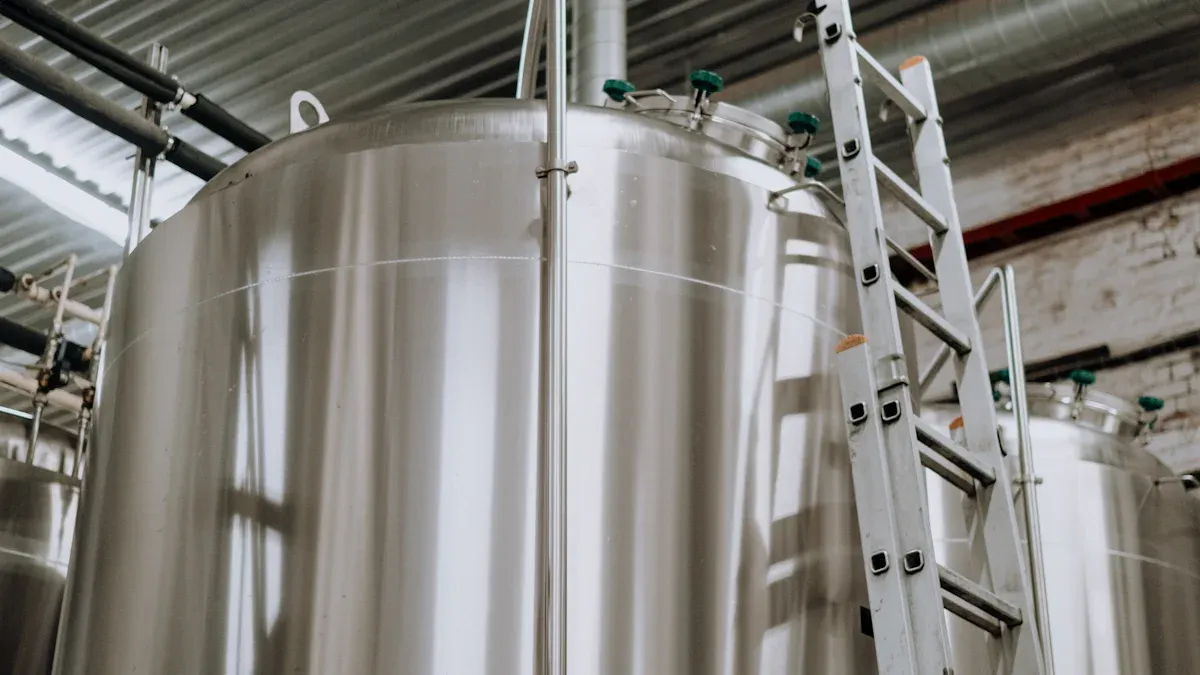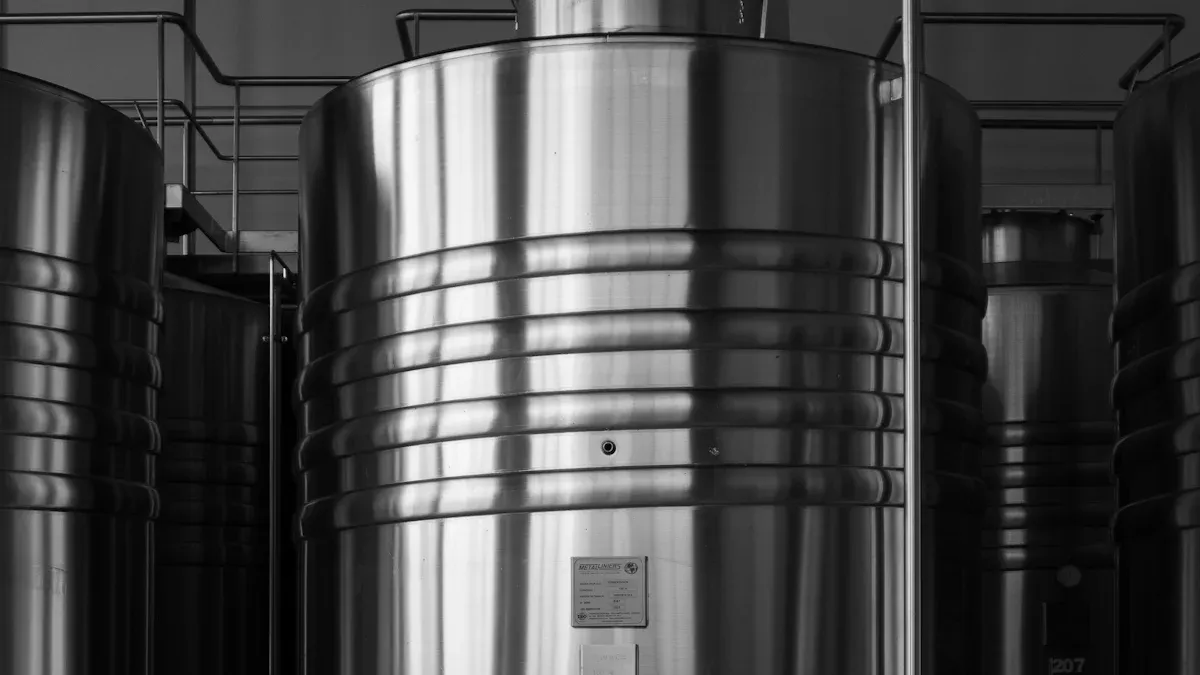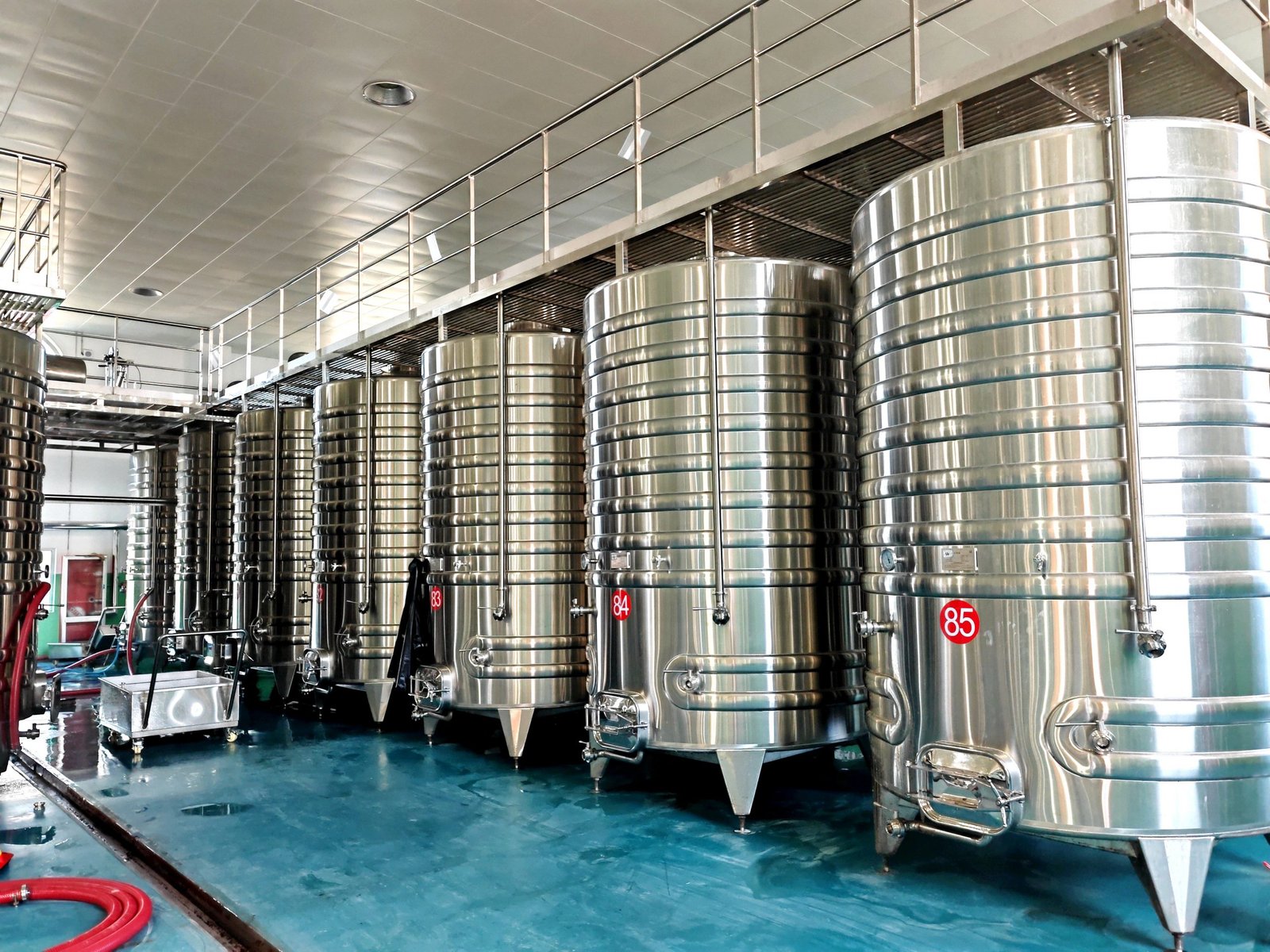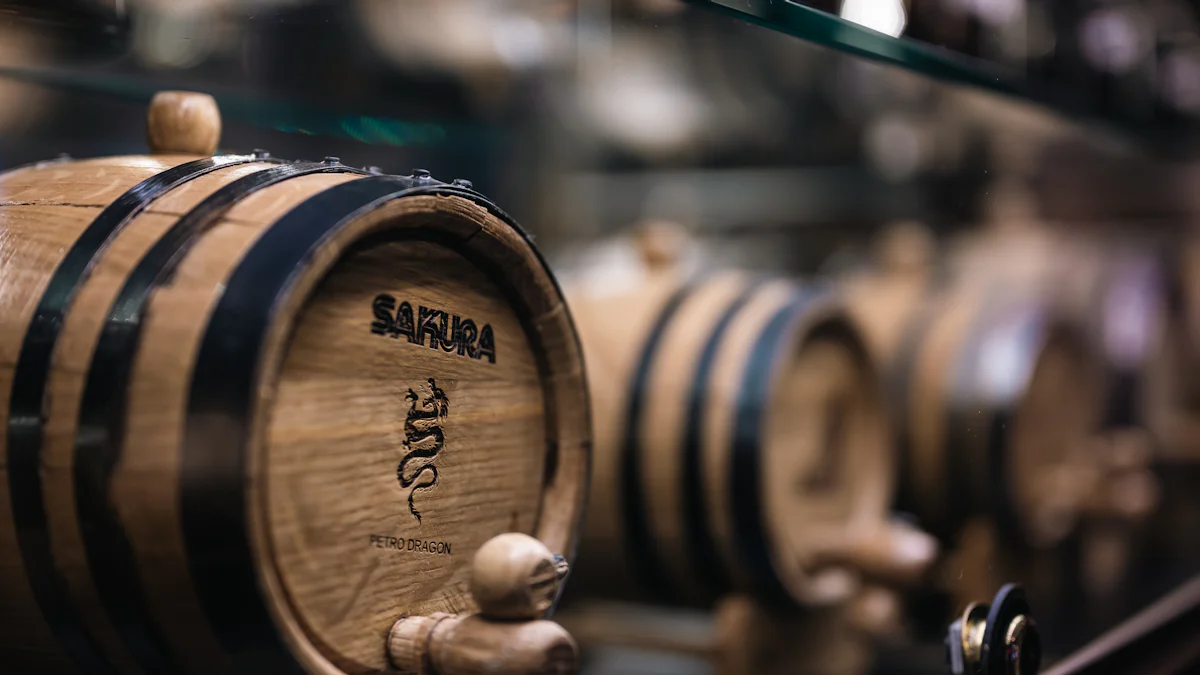
Choosing the right material for fermentation tanks wine plays a vital role in winemaking. The tank material directly affects the flavor, production efficiency, and overall cost. For instance, stainless steel tanks offer high durability and efficiency, while wood tanks enhance flavor complexity but demand more maintenance. Each material comes with unique benefits and challenges. Some, like concrete, require proper sealing to prevent oxygen exposure, while others, like polymer, may struggle with durability. By understanding these factors, you can align your tank choice with your production goals and desired wine characteristics.
Understanding the Role of Wine Tanks
Importance of Fermentation Tanks in Winemaking
Fermentation tanks play a critical role in the winemaking process. These tanks provide a controlled environment where the chemical and biological processes of fermentation occur. They protect the fermenting wine from contaminants, ensuring the purity of the final product. Temperature regulation is another essential function. By maintaining optimal temperatures, fermentation tanks support yeast metabolism, which directly impacts the flavor and quality of the wine.
Agitation and mixing within the tanks ensure uniform fermentation, promoting yeast health and activity. This process also helps distribute nutrients evenly throughout the wine. Additionally, fermentation tanks simplify sediment separation. By allowing sediments to settle at the bottom, they make it easier to remove unwanted particles, improving the clarity and filtering process.
Without these tanks, achieving consistent and high-quality wine would be nearly impossible. They are the backbone of modern winemaking, ensuring efficiency and precision at every step.
Overview of Common Materials for Wine Tanks
Choosing the right material for your wine tanks is essential. Each material offers unique properties that influence the wine fermentation process. Below is a comparison of the most commonly used materials:
| Material | Properties | |——————|—————————————————————————| | Stainless Steel | Excellent temperature regulation, easy to clean, non-reactive to flavor. | | Wood (Oak) | Adds tannins and flavor, enhances texture, but requires more maintenance. | | Concrete | Allows micro-oxygenation, enhances complexity and texture of wine. | | Polyethylene | Lightweight, affordable, suitable for small-scale production. | | Glass | Non-reactive, ideal for small-scale or experimental winemaking. |
Stainless steel is the most popular choice due to its durability and ease of maintenance. Wooden tanks, often made from oak, are traditional and impart unique flavors to the wine. Concrete tanks are gaining popularity for their ability to regulate temperature naturally and allow micro-oxygenation, which adds complexity to the wine. Polyethylene and glass are more affordable options, often used for small-scale or experimental batches.
Understanding the properties of these materials helps you select the best option for your production goals and desired wine characteristics. Whether you aim for efficiency, tradition, or innovation, the material of your fermentation tanks wine will significantly impact the final product.
Stainless Steel Fermentation Tanks Wine
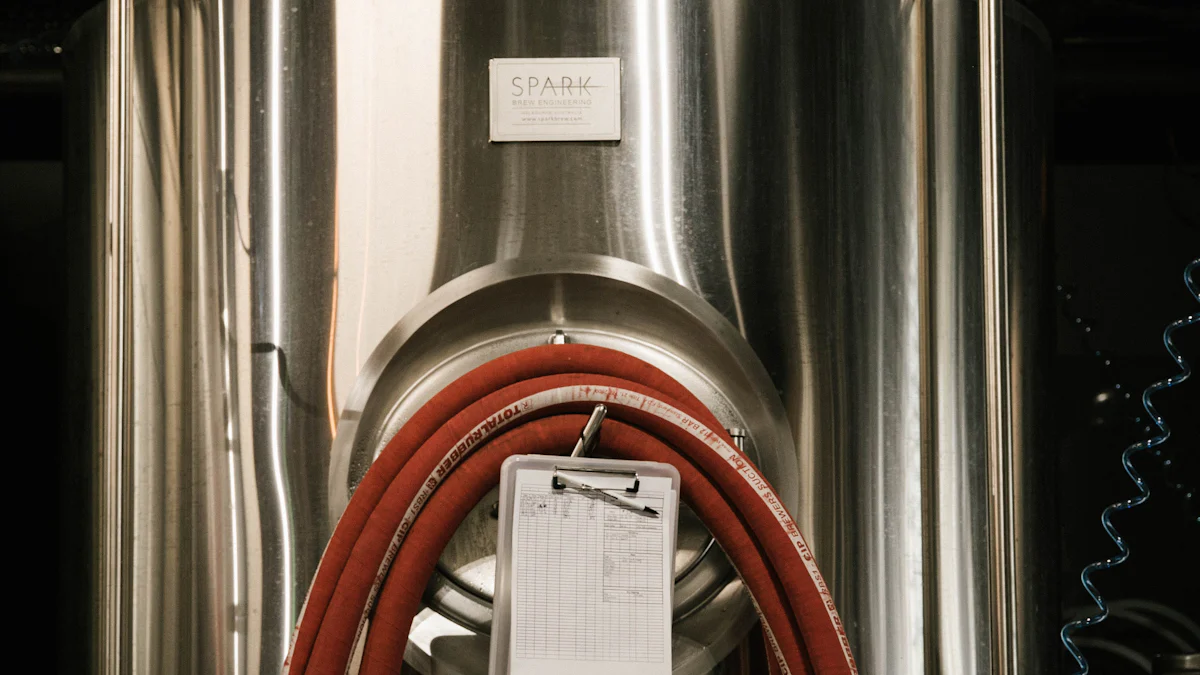
Advantages of Stainless Steel Tanks
Durability and Longevity
Stainless steel tanks are known for their exceptional durability. These tanks resist corrosion and wear, making them a long-lasting choice for winemaking. Unlike materials like wood or plastic, stainless steel withstands high temperatures and harsh environments without degrading. Its strong sealing properties also protect the wine from oxidation during the fermentation process. With proper care, these tanks can outlast other types of tanks, providing a reliable solution for years.
Easy Cleaning and Maintenance
The smooth, non-porous surface of stainless steel makes cleaning and maintenance straightforward. This material resists bacteria buildup, ensuring a hygienic environment for the fermentation process. You can easily sanitize these tanks without worrying about lingering odors or flavors. Their non-toxic nature and resistance to rust further simplify upkeep, saving you time and effort.
Temperature Control Capabilities
Temperature control is crucial in winemaking, and stainless steel excels in this area. These tanks allow precise regulation of fermentation temperatures, which is essential for producing high-quality wine. You can integrate cooling or heating systems directly into the tank, ensuring consistent conditions throughout the process. This feature helps preserve the wine’s natural characteristics and enhances its overall quality.
Disadvantages of Stainless Steel Tanks
Higher Initial Cost
Stainless steel tanks require a higher upfront investment compared to other materials like plastic or polyethylene. However, their durability and low maintenance costs often offset this initial expense over time.
Limited Impact on Wine Flavor
Unlike wooden tanks, stainless steel does not impart additional flavors or tannins to the wine. While this is ideal for preserving the wine’s original profile, it may not suit winemakers seeking to add complexity through the fermentation tanks wine.
Best Uses for Stainless Steel Tanks
Ideal for Crisp, Clean Wine Styles
Stainless steel tanks are perfect for producing crisp white wines and other clean styles. They do not alter the wine’s flavor, allowing the fruit’s natural characteristics to shine. This makes them a popular choice for winemakers aiming to highlight the purity of their product.
Suitable for Large-Scale Production
The durability and efficiency of stainless steel tanks make them ideal for large-scale wine production. Their ability to handle significant volumes without compromising quality ensures consistent results. These tanks also streamline the fermentation process, making them a practical option for commercial wineries.
Why Chenma Stainless Steel Tanks Stand Out
Customization and Technical Expertise
Chenma stainless steel tanks excel in meeting the unique needs of winemakers. The company prioritizes customization, offering tailored solutions for your wine fermentation process. A team of skilled engineers works closely with you to design tanks that align with your production goals. Whether you need tanks for large-scale operations or small-batch artisan wines, Chenma adapts its designs to fit your requirements.
The manufacturing process at Chenma incorporates cutting-edge technology. This ensures that every tank meets the highest standards of precision and quality. The company’s advanced machinery allows for the creation of even the most complex tank designs. This level of innovation ensures that your wine tanks not only perform efficiently but also last for years.
Here’s a quick overview of what makes Chenma stand out:
| Feature | Description | |—————————–|————————————————————————————————-| | Innovative Manufacturing | Chenma employs cutting-edge technology in its manufacturing processes, ensuring high standards. | | Custom Design Capabilities | Customization is key, with a professional engineering team to create tanks that fit unique needs. | | Quality Assurance | Commitment to quality is evident with certifications like ISO9001 and EU CE, ensuring durability. |
By choosing Chenma, you gain access to a partner who understands the importance of precision and adaptability in winemaking.
Compliance with Safety and Quality Standards
Chenma stainless steel tanks are built with a strong focus on safety and quality. The company adheres to internationally recognized standards, ensuring that every tank meets rigorous requirements. Certifications such as ISO9001, ISO14001, and EU CE highlight Chenma’s commitment to excellence. These certifications guarantee that the tanks are durable, environmentally friendly, and safe for use in the fermentation process.
Chenma also prioritizes occupational health and safety. The company has achieved OHSAS18001 certification, reflecting its dedication to creating safe working environments. This focus on compliance ensures that your tanks not only perform well but also meet all regulatory requirements.
When you choose Chenma, you invest in stainless steel tanks that combine reliability, safety, and quality. These tanks provide a secure environment for wine fermentation, helping you produce exceptional wine while maintaining peace of mind.
Wooden Wine Tanks
Advantages of Wooden Tanks
Adds Complexity and Flavor to Wine
Wooden tanks bring a unique dimension to the wine fermentation process. They enhance the flavor profile by imparting subtle notes of wood, vanilla, and spice. These flavors develop as the wine interacts with the oak during fermentation. Over time, the wine gains complexity, creating a richer and more layered taste. Wooden tanks also allow for controlled oxygenation, which softens the wine and smooths its texture. This process can add structure through tannins, giving the wine a balanced and refined character.
Aesthetic Appeal and Tradition
Wood tanks carry a deep sense of tradition. They have been used for centuries in winemaking, symbolizing craftsmanship and heritage. Their natural appearance adds an aesthetic charm to wineries, creating a rustic and authentic atmosphere. For many winemakers, using wooden tanks is not just about the wine but also about preserving a timeless art form.
Disadvantages of Wooden Tanks
High Maintenance Requirements
Wooden tanks demand significant upkeep. Their porous nature makes them prone to absorbing liquids, which can lead to bacterial growth if not cleaned thoroughly. Regular maintenance, including cleaning and rehydration, is essential to prevent contamination. This level of care requires time and expertise, making wooden tanks less practical for some producers.
Susceptibility to Contamination
The porous surface of wood increases the risk of contamination. If not properly sanitized, wooden tanks can harbor unwanted microorganisms that may affect the wine’s quality. This susceptibility makes them less forgiving than materials like stainless steel, which are easier to sterilize.
Best Uses for Wooden Tanks
Ideal for Aging and Complex Wines
Wooden tanks excel in producing wines that benefit from aging. They are particularly suited for wines that require added complexity and depth. For example, oak fermentation enhances flavors with notes of vanilla, nuttiness, and spice. It also facilitates malolactic fermentation, which adds a creamy texture and enhances the wine’s overall character.
- Oak enriches the wine with complex flavors.
- Oxygenation smooths and softens the wine over time.
- Tannins from the wood add structure and texture.
- Malolactic fermentation creates a creamy, balanced finish.
Best for Small-Scale or Artisan Producers
Wooden tanks are ideal for small-scale or artisan winemakers. Their traditional appeal and ability to produce unique, high-quality wines make them a favorite among boutique wineries. These tanks allow winemakers to focus on craftsmanship, creating wines that stand out for their character and individuality.
If you value tradition and wish to craft wines with complexity and depth, wooden tanks offer an unparalleled option.
Concrete Fermentation Tanks Wine
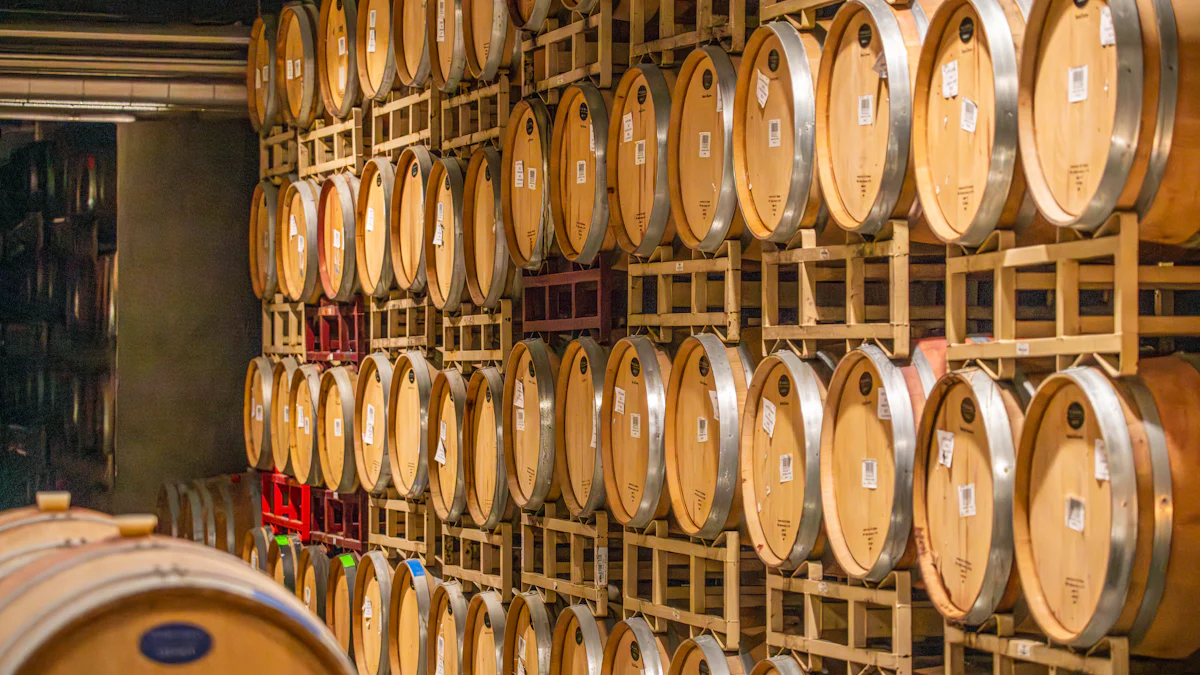
Advantages of Concrete Tanks
Natural Temperature Regulation
Concrete fermentation tanks excel in maintaining stable temperatures during the fermentation process. Their thick walls act as natural insulators, gradually warming and cooling the wine. This slow temperature regulation creates a controlled environment, reducing the risk of sudden temperature fluctuations. You can rely on this feature to ensure consistent fermentation, which is essential for producing high-quality wine.
Micro-Oxygenation Benefits
The porous nature of concrete allows small amounts of oxygen to pass through the tank walls. This micro-oxygenation process benefits the wine by softening tannins and enhancing its texture. Unlike oak barrels, concrete tanks provide these advantages without adding external flavors. This makes them ideal for winemakers who want to highlight the grape’s natural characteristics and the terroir. Many wineries also use egg-shaped concrete tanks to improve the movement of wine and lees, further enhancing the wine’s quality.
Disadvantages of Concrete Tanks
Heavy and Difficult to Move
Concrete tanks are significantly heavier than other materials like stainless steel or plastic. Their weight makes them challenging to transport or reposition within your winery. Once installed, these tanks typically remain in place, limiting flexibility in your production setup.
Porosity Requires Proper Sealing
While the porous nature of concrete offers benefits, it also requires careful sealing. Without proper sealing, the tank can absorb liquids and harbor bacteria, compromising the wine’s quality. Regular maintenance and resealing are necessary to ensure a hygienic fermentation environment.
Best Uses for Concrete Tanks
Ideal for Balanced, Textured Wines
Concrete tanks are perfect for wines that benefit from gradual fermentation and micro-oxygenation. They allow you to create balanced wines with enhanced texture and complexity. These tanks also provide a clean expression of the grape and its terroir, making them a favorite for winemakers focused on authenticity.
Popular in Boutique Wineries
Boutique wineries often choose concrete tanks for their ability to produce unique, high-quality wines. The egg-shaped designs, in particular, encourage natural movement within the tank, improving contact with the lees. This feature enhances the wine’s flavor and texture, making concrete tanks a valuable tool for small-scale, artisanal production.
If you aim to showcase the true essence of your wine while achieving a refined texture, concrete fermentation tanks offer an excellent solution.
Amphorae Wine Tanks
Advantages of Amphorae
Unique Flavor Profiles
Amphorae wine tanks offer a distinctive approach to winemaking, creating wines with unique flavor profiles. The porous terracotta clay used in these tanks allows for natural micro-oxygenation, which enhances the wine’s texture and flavor. This process softens tannins and accelerates the development of tertiary flavors. You’ll notice earthy and mineral notes, along with hints of nuts, baked fruit, and chocolate. Wines fermented in amphorae also exhibit enhanced aromatics, making them stand out for their complexity and depth.
Natural Micro-Oxygenation
The natural micro-oxygenation provided by amphorae tanks plays a crucial role in shaping the wine’s character. The clay’s porosity allows small amounts of oxygen to interact with the wine during fermentation and aging. This controlled oxygen exposure smooths the wine’s texture and balances its structure. Unlike wooden barrels, amphorae do not impart additional flavors, letting the wine express its true terroir. This makes them an excellent choice for winemakers aiming to highlight the authenticity of their grapes.
Disadvantages of Amphorae
Fragility and Risk of Breakage
Amphorae tanks are fragile and prone to breakage. Their terracotta construction, while beneficial for fermentation, makes them less durable than materials like stainless steel or concrete. Handling these tanks requires extra care, increasing the labor involved in their use.
Limited Availability and High Cost
The availability of amphorae tanks is limited, and they are more expensive than other options. Sourcing these tanks can be challenging, especially for larger wineries. The labor-intensive nature of their use further adds to the overall cost. Despite these challenges, many winemakers justify the investment for the unique qualities amphorae bring to their wine.
Best Uses for Amphorae
Ideal for Natural and Experimental Wines
Amphorae tanks are perfect for producing natural and experimental wines. Their porous clay construction supports natural fermentation processes, enhancing the wine’s texture and flavor. Indigenous grape varieties, such as Nero d’Avola or Sangiovese, thrive in these tanks, resulting in wines that reflect their local terroir. The micro-oxygenation process also allows winemakers to experiment with unique flavor profiles, making amphorae a favorite for innovative wine styles.
Best for Small-Scale Production
Amphorae tanks work best for small-scale production. Their artisanal appeal and ability to produce high-quality, terroir-driven wines make them ideal for boutique wineries. These tanks allow you to focus on craftsmanship, creating wines that stand out for their authenticity and individuality. If you value tradition and innovation, amphorae tanks offer a compelling option for your winemaking journey.
Plastic Fermentation Tanks Wine
Advantages of Plastic Tanks
Affordable and Lightweight
Plastic tanks offer a cost-effective solution for winemaking. Their lightweight construction makes them easy to handle and reduces transportation costs. Compared to materials like stainless steel, plastic tanks are significantly less expensive. This affordability makes them an attractive option for winemakers working with limited budgets.
- Polymer materials, such as plastic, are both lightweight and low-cost.
- Plastic tanks provide a cost advantage over more expensive materials like stainless steel.
- Their price range is budget-friendly, making them accessible to small-scale producers.
Easy to Transport and Store
The lightweight nature of plastic tanks simplifies transportation and storage. You can easily move these tanks around your winery without requiring heavy equipment. Their compact design also allows for efficient storage when not in use. This flexibility makes plastic tanks a practical choice for winemakers who need adaptable solutions for their production setup.
Disadvantages of Plastic Tanks
Limited Durability
Plastic tanks lack the durability of materials like stainless steel or concrete. Over time, they may degrade, especially when exposed to extreme temperatures or prolonged use. This limited lifespan makes them less suitable for long-term or large-scale wine production.
Potential for Chemical Leaching
Plastic tanks pose a risk of chemical leaching, which can affect the quality of your wine. Additives in plastic, such as plasticizers like DEHP, may leach into the wine under certain conditions. Studies have shown that these chemicals can disrupt ecosystems and even impact human health. To minimize this risk, you should ensure that your plastic tanks meet food-grade standards and avoid prolonged exposure to high temperatures.
Best Uses for Plastic Tanks
Suitable for Small-Scale or Experimental Batches
Plastic tanks work well for small-scale production or experimental winemaking. Their affordability and lightweight design make them ideal for testing new wine styles or processes. The oxygen permeability of some plastic tanks can also enhance specific fermentation techniques, adding versatility to your winemaking toolkit.
Ideal for Budget-Conscious Producers
If you’re looking for an economical option, plastic tanks are a great choice. They allow you to allocate more resources to other aspects of winemaking, such as grape selection or marketing. For budget-conscious producers, these tanks provide a practical way to achieve quality results without overspending.
Plastic tanks offer a balance of affordability and functionality, making them a valuable tool for certain winemaking scenarios.
Key Considerations for Choosing Wine Tanks
Cost and Budget Constraints
When selecting wine tanks, understanding your budget is essential. The type of material significantly impacts the cost. For example, stainless steel tanks made from 316-grade steel often cost more than those made from 304-grade steel due to their enhanced corrosion resistance. Construction quality also plays a role. Tanks built to industry standards may have a higher price tag, but their durability and safety features justify the investment.
You should also consider the supplier’s reputation. Established brands often charge more, but they provide quality assurance and reliable customer support. Comparing prices from multiple suppliers can help you identify cost-effective options. While upfront costs might seem high, think about long-term value. A durable tank may reduce maintenance expenses over time, making it a more economical choice in the long run.
Maintenance and Cleaning Requirements
Proper maintenance ensures your fermentation tanks remain efficient and hygienic. After each use, clean the tank thoroughly to remove residues. Use a suitable detergent to prevent corrosion and disinfect all parts that come into contact with the wine. Regularly inspect seals and connections to avoid leaks.
For tanks with electrical components, clean heating elements carefully to prevent damage. Calibrate sensors and instrumentation annually to maintain accuracy. If you’re using plastic tanks, handle them gently to avoid scratches that could harbor bacteria. Performing a deep clean on new tanks removes any manufacturing residues, ensuring a safe start to your winemaking process.
Safety and Regulatory Compliance
Safety and compliance are non-negotiable when choosing fermentation tanks. Look for tanks with ASME certification, which ensures they can handle pressurized processes safely. Materials must comply with FDA standards to guarantee they are food-safe. In the European market, tanks should carry CE marking to meet health and safety regulations.
Environmental standards also matter. Tanks designed with energy efficiency and waste management in mind align with sustainable practices. Third-party certifications, such as ISO9001, provide additional assurance of quality and safety. By prioritizing compliance, you protect both your wine and your workers, creating a safe and efficient production environment.
Choosing the right tank involves balancing cost, maintenance, and safety. By evaluating these factors, you can make an informed decision that supports your winemaking goals.
Impact on Wine Style and Flavor
The material of your fermentation tank plays a significant role in shaping the style and flavor of your wine. Each tank material interacts differently with the wine, influencing its texture, aroma, and overall profile.
Stainless steel tanks are ideal if you want to preserve the natural characteristics of your wine. These tanks provide excellent temperature control, which helps maintain the purity of the grape’s flavor. They do not impart any additional aromas or tastes, making them perfect for crisp and clean wine styles. For example, stainless steel tanks work well for producing fresh white wines or light-bodied reds.
Concrete tanks offer a unique advantage by creating a micro-oxygenation environment. This process allows small amounts of oxygen to interact with the wine, softening tannins and enhancing texture. Concrete tanks also help develop complexity without adding external flavors. This makes them a great choice for balanced wines that highlight the grape’s terroir. Many boutique wineries use concrete tanks to craft wines with refined textures and layered profiles.
Wooden tanks, often made from oak, add distinct flavors and aromas to the wine. As the wine ferments, it absorbs subtle notes of vanilla, spice, and wood. This interaction adds depth and character, making wooden tanks ideal for wines that benefit from aging. The controlled oxygenation in wooden tanks also smooths the wine’s texture, creating a rich and full-bodied result.
Plastic tanks, while affordable and lightweight, have minimal impact on the wine’s flavor. They are best suited for small-scale or experimental batches where cost and convenience are priorities. However, they may not provide the same level of flavor enhancement as other materials.
Your choice of tank material should align with your production goals and the style of wine you want to create. Whether you aim for purity, complexity, or tradition, the right tank can elevate your winemaking process.
Comparing Materials for Fermentation Tanks Wine
Side-by-Side Comparison of Key Features
When evaluating fermentation tank materials, you should focus on their most important features. These features determine how well the tanks perform during the winemaking process and how they align with your production needs.
- Durability: Stainless steel stands out for its long-lasting nature. It resists corrosion and wear, making it a reliable choice for professional winemakers.
- Ease of Cleaning: Sanitation is critical in winemaking. Stainless steel and polyethylene tanks are easy to clean, while wooden tanks require more effort due to their porous surfaces.
- Temperature Control: Stainless steel and concrete tanks excel in maintaining consistent temperatures. This feature is essential for producing high-quality wine.
- Impact on Flavor: Wooden tanks add unique flavors and aromas, while stainless steel preserves the wine’s natural characteristics. Concrete enhances texture without altering flavor.
- Cost: Plastic tanks are the most affordable, while stainless steel and amphorae tanks require a higher investment.
Here’s a quick comparison of key features:
| Material | Durability | Ease of Cleaning | Temperature Control | Flavor Impact | Cost |
|———————–|—————-|———————–|————————–|——————-|—————-|
| Stainless Steel | High | Easy | Excellent | None | High |
| Concrete | Medium | Moderate | Good | None | Medium |
| Wood (Oak) | Medium | Difficult | Moderate | Adds Complexity | High |
| Polyethylene (Plastic)| Low | Easy | Limited | None | Low |
| Amphorae (Clay) | Low | Moderate | Moderate | Unique Profiles | High |
This table helps you compare materials side by side, making it easier to identify the best option for your winery.
Matching Materials to Wine Styles and Production Goals
The tanks you choose for your winery are just as important as the grapes you grow. Each material interacts differently with the wine, shaping its flavor, texture, and overall quality. Matching the right tank to your production goals ensures you achieve the desired results.
For crisp and clean wine styles, stainless steel tanks are ideal. They preserve the grape’s natural characteristics and provide precise temperature control. If you aim to create wines with complexity and depth, wooden tanks are a better choice. They impart distinct flavors and aromas, adding richness to the final product.
Concrete tanks work well for balanced wines with enhanced texture. Their micro-oxygenation process softens tannins and highlights the wine’s terroir. For small-scale or experimental batches, plastic tanks offer an affordable and lightweight solution. Amphorae tanks, on the other hand, are perfect for natural and artisanal wines. They create unique flavor profiles that stand out in the market.
Here’s a summary of how different materials align with wine styles and goals:
| Type of Tank | Material | Key Features |
|———————–|———————-|—————————————————-|
| Stainless Steel Tanks | Stainless Steel | Excellent temperature control, non-reactive |
| Concrete Tanks | Concrete | Micro-oxygenation, enhances complexity and texture |
| Wooden Tanks | Oak or Other Wood | Imparts distinct flavors, adds depth and character |
| Polyethylene Tanks | Polyethylene | Lightweight, affordable, suitable for small batches|
| Amphorae Tanks | Terracotta Clay | Unique flavor profiles, natural micro-oxygenation |
By aligning tank materials with your production goals, you can elevate your winemaking process and create wines that reflect your vision.
Selecting the right fermentation tank material is essential for achieving your winemaking goals. Each material offers unique advantages and challenges. Stainless steel provides durability and precise temperature control, while wooden tanks enhance flavor complexity. Concrete tanks balance texture and terroir expression, and amphorae create unique profiles. Plastic tanks, though cost-effective, suit small-scale or experimental batches.
Align your choice with your production scale and desired wine style. For example, stainless steel suits large-scale operations, while wooden tanks excel in crafting aged, complex wines. Consider your budget, ensuring the tank meets essential winemaking conditions without overspending. Opt for tanks with temperature control systems and choose reputable brands for quality assurance.
Choosing the wrong material can impact wine quality, from unwanted flavors in plastic tanks to sanitation challenges in concrete. Prioritize long-term usability and flavor alignment to craft exceptional wine.
FAQ
What is the best material for wine fermentation tanks?
The best material depends on your goals. Stainless steel works well for clean, crisp wines. Wood enhances flavor complexity. Concrete balances texture and terroir. Plastic suits small-scale or budget-conscious production. Amphorae create unique profiles for artisanal wines. Match the material to your wine style and production needs.
How do I clean and maintain fermentation tanks?
Use food-safe detergents to clean tanks after each use. Sanitize thoroughly to prevent contamination. Inspect seals and connections regularly. For wooden tanks, rehydrate them to avoid cracks. Stainless steel and plastic tanks require less maintenance compared to wood or concrete.
Can I use multiple tank materials in one winery?
Yes, combining materials can enhance your production. Use stainless steel for fermentation and wood for aging. Concrete or amphorae can add texture and complexity. Mixing materials allows you to craft diverse wine styles while optimizing production efficiency.
Are plastic tanks safe for winemaking?
Plastic tanks are safe if they meet food-grade standards. Avoid prolonged exposure to high temperatures to prevent chemical leaching. They work best for small-scale or experimental batches. Always verify the quality of the plastic before use.
How does tank material affect wine flavor?
Tank material influences flavor and texture. Stainless steel preserves natural characteristics. Wood adds tannins and complexity. Concrete enhances texture through micro-oxygenation. Amphorae create earthy, unique profiles. Plastic has minimal impact on flavor but offers affordability for small-scale production.

